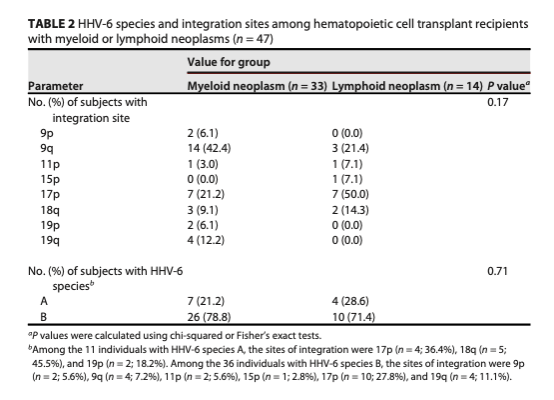A large study of iciHHV-6 integration sites found integration at 9q more common in hematologic malignancies—but the study lacked power to draw firm conclusions.
Investigators at Fred Hutchinson Cancer Center in Seattle, led by Joshua Hill, MD, screened 8,638 transplant donors and blood cancer patients. They identified 102 individuals with inherited chromosomally-integrated HHV-6 (iciHHV-6): 41 donors and 61 cancer patients. Of those, the integration site was identified in 30 donors and 47 recipients.
HHV-6B represented 78% of the cases and the most common integration sites were 9q and 17p, consistent with past studies of populations of European descent. In Japan, however, HHV-6A represents 43% of iciHHV-6 cases and chromosome 22 is the most common integration site (Miura 2018).
Since, theoretically, HHV-6 integration at specific locations could promote oncogenesis by disrupting local telomere stability, and since a similar virus (Marek’s disease virus) is linked to hematologic malignancies in fowl, the investigators assessed whether integration at specific sites might be associated with hematologic malignancies.

Integration at 9q was twice as frequent in HCT recipients (17/47, 36%) as in healthy donors (5/30, 17%), but this difference was not statistically significant. As shown in the table, above, integration at 9q also was twice as common in myeloid malignancies (14/33, 42%) as in lymphoid malignancies (3/14, 21%), but this difference, too, was not statistically significant.
Despite the fact that a large number of donors and patients were studied, the number of people with iciHHV-6 was small enough that the study did not have much statistical power to recognize these differences as significant. So, the possibility that the 9q integration site for iciHHV-6 may render people vulnerable to hematologic malignancies, particularly myeloid malignancies, must await larger studies.
Read the full paper: Heldman 2022

